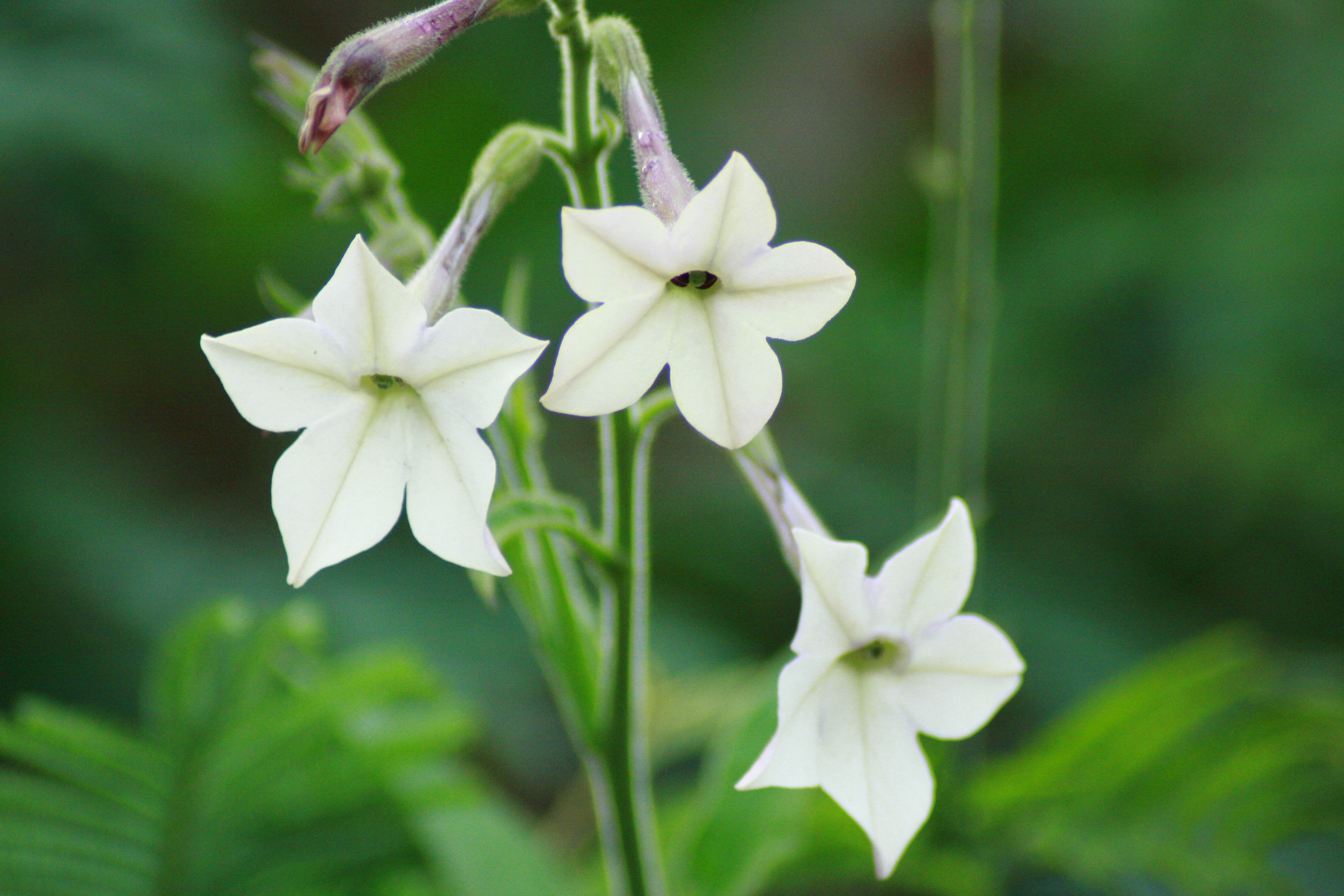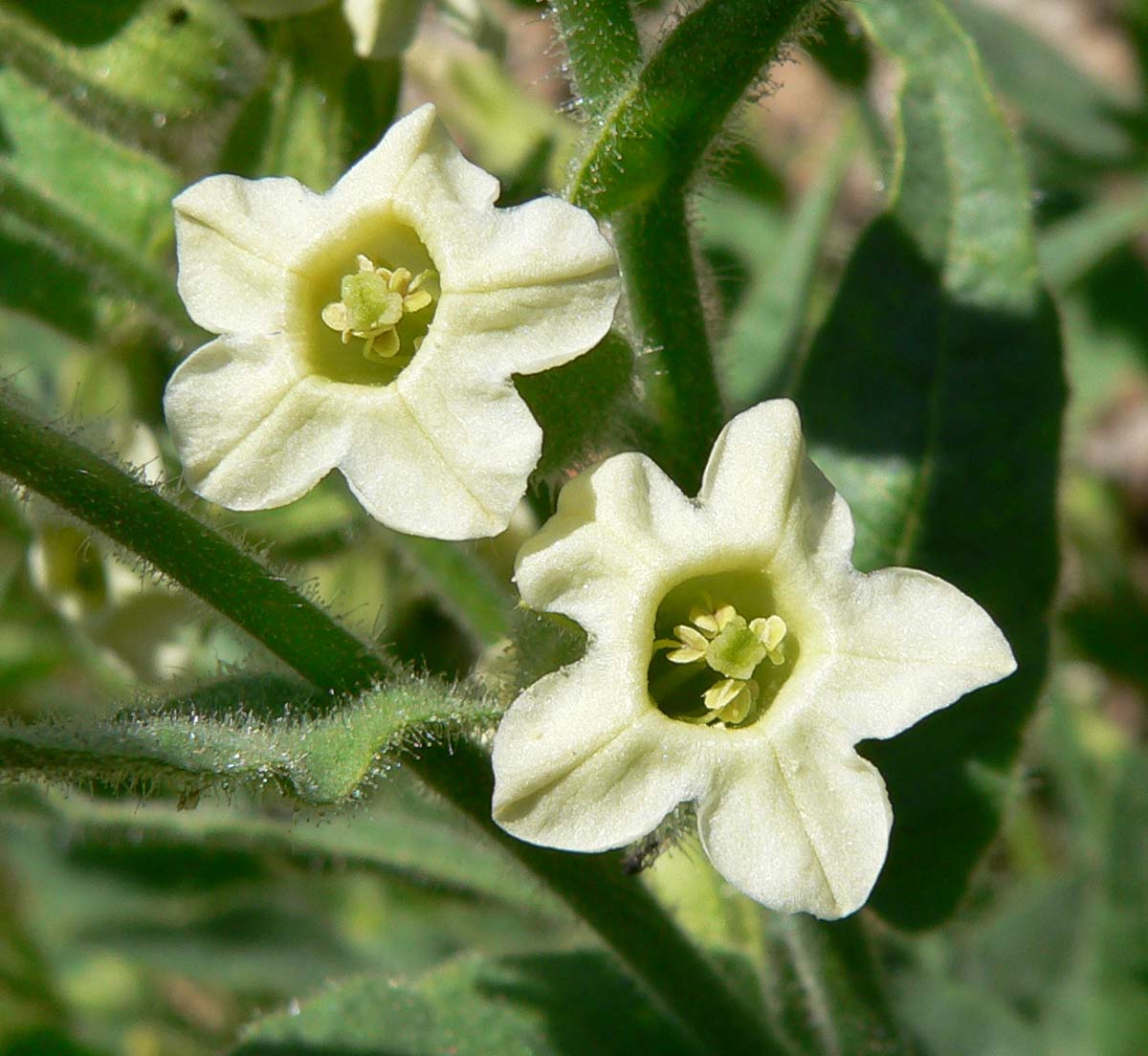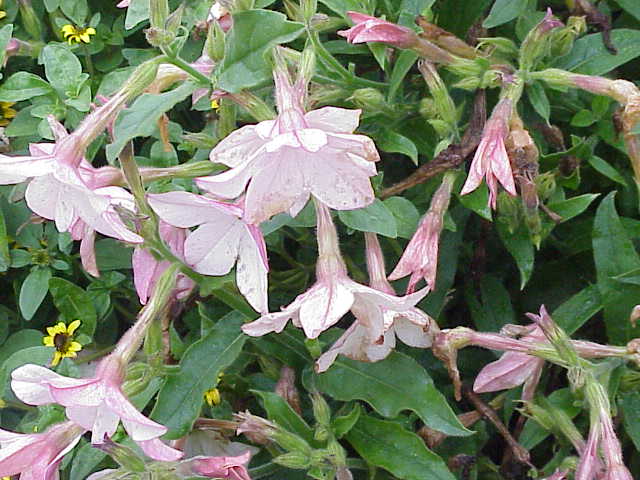nicotiana on:
[Wikipedia]
[Google]
[Amazon]
''Nicotiana'' () is a
 The 79 accepted species include:
* '' Nicotiana acuminata'' (Graham) Hook. – manyflower tobaccoKnapp et al. (2004) Nomenclatural changes and a new sectional classification in Nicotiana (Solanaceae) Taxon. 53(1):73-82.
* '' Nicotiana africana'' Merxm.
* '' Nicotiana alata'' Link & Otto – jasmine tobacco, sweet tobacco, winged tobacco, Persian tobacco, ''tanbaku'' (in Persian)
* '' Nicotiana attenuata'' Torrey ex S. Watson – coyote tobacco
* '' Nicotiana benthamiana''
The 79 accepted species include:
* '' Nicotiana acuminata'' (Graham) Hook. – manyflower tobaccoKnapp et al. (2004) Nomenclatural changes and a new sectional classification in Nicotiana (Solanaceae) Taxon. 53(1):73-82.
* '' Nicotiana africana'' Merxm.
* '' Nicotiana alata'' Link & Otto – jasmine tobacco, sweet tobacco, winged tobacco, Persian tobacco, ''tanbaku'' (in Persian)
* '' Nicotiana attenuata'' Torrey ex S. Watson – coyote tobacco
* '' Nicotiana benthamiana''
 Despite containing enough nicotine and/or other compounds such as germacrene and anabasine and other piperidine alkaloids (varying between species) to deter most herbivores, a number of such animals have evolved the ability to feed on ''Nicotiana'' species without being harmed. Nonetheless, tobacco is unpalatable to many species and therefore some tobacco plants (chiefly tree tobacco ('' N. glauca'')) have become established as
Despite containing enough nicotine and/or other compounds such as germacrene and anabasine and other piperidine alkaloids (varying between species) to deter most herbivores, a number of such animals have evolved the ability to feed on ''Nicotiana'' species without being harmed. Nonetheless, tobacco is unpalatable to many species and therefore some tobacco plants (chiefly tree tobacco ('' N. glauca'')) have become established as 




''Nicotiana''
Retrieved 2007-11-20. * *
The Plant List
{{Authority control Entheogens Solanaceae genera Tobacco az:Tütün de:Tabak nv:Nátʼoh (chʼil)
genus
Genus ( plural genera ) is a taxonomic rank used in the biological classification of living and fossil organisms as well as viruses. In the hierarchy of biological classification, genus comes above species and below family. In binomial n ...
of herbaceous plants and shrubs in the family
Family (from la, familia) is a group of people related either by consanguinity (by recognized birth) or affinity (by marriage or other relationship). The purpose of the family is to maintain the well-being of its members and of society. Idea ...
Solanaceae
The Solanaceae , or nightshades, are a family of flowering plants that ranges from annual and perennial herbs to vines, lianas, epiphytes, shrubs, and trees, and includes a number of agricultural crops, medicinal plants, spices, weeds, and o ...
, that is indigenous to the Americas, Australia, Southwestern Africa and the South Pacific. Various ''Nicotiana'' species
In biology, a species is the basic unit of Taxonomy (biology), classification and a taxonomic rank of an organism, as well as a unit of biodiversity. A species is often defined as the largest group of organisms in which any two individuals of ...
, commonly referred to as tobacco plants, are cultivated as ornamental garden plants. '' N. tabacum'' is grown worldwide for the cultivation of tobacco leaves used for manufacturing and producing tobacco products, including cigars, cigarillos, cigarettes, chewing tobacco, dipping tobacco, snuff, and snus.
Taxonomy
Species
 The 79 accepted species include:
* '' Nicotiana acuminata'' (Graham) Hook. – manyflower tobaccoKnapp et al. (2004) Nomenclatural changes and a new sectional classification in Nicotiana (Solanaceae) Taxon. 53(1):73-82.
* '' Nicotiana africana'' Merxm.
* '' Nicotiana alata'' Link & Otto – jasmine tobacco, sweet tobacco, winged tobacco, Persian tobacco, ''tanbaku'' (in Persian)
* '' Nicotiana attenuata'' Torrey ex S. Watson – coyote tobacco
* '' Nicotiana benthamiana''
The 79 accepted species include:
* '' Nicotiana acuminata'' (Graham) Hook. – manyflower tobaccoKnapp et al. (2004) Nomenclatural changes and a new sectional classification in Nicotiana (Solanaceae) Taxon. 53(1):73-82.
* '' Nicotiana africana'' Merxm.
* '' Nicotiana alata'' Link & Otto – jasmine tobacco, sweet tobacco, winged tobacco, Persian tobacco, ''tanbaku'' (in Persian)
* '' Nicotiana attenuata'' Torrey ex S. Watson – coyote tobacco
* '' Nicotiana benthamiana'' Domin
Karel Domin (4 May 1882, Kutná Hora, Kingdom of Bohemia – 10 June 1953, Prague) was a Czech botanist and politician.
After gymnasium school studies in Příbram
Příbram (; german: Freiberg in Böhmen, ''Przibram'', or ''Pribram'', ...
– benth, benthi
* '' Nicotiana clevelandii'' A. Gray – Cleveland's tobacco
* '' Nicotiana glauca'' Graham – tree tobacco, Brazilian tree tobacco, shrub tobacco, wild tobacco, tobacco plant, tobacco bush, tobacco tree, mustard tree
* ''Nicotiana glutinosa
''Nicotiana glutinosa'' is a species of tobacco plant that is economically important in tobacco hybrids. ''N. glutinosa'' is native to western South America, including Bolivia, Ecuador, and Peru. It is a model organism for the study of Tobacco mo ...
'' L.
* ''Nicotiana langsdorffii
''Nicotiana langsdorffii'', Langsdorff's tobacco, is a species of flowering plant in the nightshade family Solanaceae, native to Brazil.
Growing to tall by broad, it is an annual plant with large sticky leaves up to
long. It bears long, nodd ...
'' Weinm. – Langsdorff's tobacco
* '' Nicotiana longiflora'' Cav. – longflower tobacco or long-flowered tobacco
* '' Nicotiana occidentalis'' H.-M. Wheeler – native tobacco
* '' Nicotiana obtusifolia'' M. Martens & Galeotti – desert tobacco, ''punche'', ''"tabaquillo"''
* ''Nicotiana otophora
''Nicotiana otophora'' is a perennial herbaceous plant. It is a wild species of tobacco native to the Andes Mountains of Bolivia and Argentina.
Tobacco taxonomy
Recent genetic evidence suggests the possibility that it is one of the parent spec ...
'' Griseb.
* ''Nicotiana plumbaginifolia
''Nicotiana plumbaginifolia'' is a species of tobacco plant known as Tex-Mex tobacco. The species epithet, "plumbaginifolia", is from the leaves bearing similarity to those of the genus ''Plumbago
''Plumbago'' is a genus of 10–20 species o ...
'' Viv. – Tex-Mex tobacco
* '' Nicotiana quadrivalvis'' Pursh – Indian tobacco
* '' Nicotiana rustica'' L. – Aztec tobacco, strong tobacco, ''mapacho''
* '' Nicotiana suaveolens'' Lehm. – Australian tobacco
* '' Nicotiana sylvestris'' Speg.
Carlo Luigi Spegazzini, in Spanish Carlos Luis Spegazzini (20 April 1858 – 1 July 1926), was an Italian-born Argentinian botanist and mycologist.
On the 1881/1882 expedition led by Giacomo Bove to explore Patagonia and Tierra del Fuego, th ...
& Comes – woodland tobacco, flowering tobacco, South American tobacco
* '' Nicotiana tabacum'' L. – common tobacco, domesticated tobacco, cultivated tobacco, commercial tobacco (grown for the production of cigars, cigarillos, cigarettes, chewing tobacco, dipping tobacco, etc.)
* ''Nicotiana tomentosiformis
''Nicotiana tomentosiformis'' is a perennial herbaceous plant. It is a wild species of tobacco native to the Yungas Valley region in the eastern piedmont of the Andes Mountains, primarily in Bolivia.
Recent genetic evidence suggests it is one o ...
'' Goodsp.
Manmade hybrids
* ''Nicotiana'' × ''didepta'' – ''N. debneyi'' × ''N. tabacum'' * ''Nicotiana'' × ''digluta'' – '' N. glutinosa'' × ''N. tabacum'' * ''Nicotiana'' × ''sanderae'' Hort. ex Wats. – ''N. alata'' × ''N. forgetiana''Formerly placed here
* '' Petunia axillaris'' (Lam.) Britton et al. (as ''N. axillaris'' Lam.) – large white petunia, wild white petunia, white moon petuniaEtymology
The genus ''Nicotiana'' (from which the word '' nicotine'' is derived) was named in honor ofJean Nicot
Jean Nicot de Villemain (; 1530 – May 4, 1604) was a French diplomat and scholar. He is famous for being the first to bring tobacco to France, including snuff tobacco. Nicotine is named after the tobacco plant ''Nicotiana tabacum,'' which in tur ...
, French ambassador to Portugal, who in 1559 sent samples as a medicine to the court of Catherine de' Medici.
Ecology
 Despite containing enough nicotine and/or other compounds such as germacrene and anabasine and other piperidine alkaloids (varying between species) to deter most herbivores, a number of such animals have evolved the ability to feed on ''Nicotiana'' species without being harmed. Nonetheless, tobacco is unpalatable to many species and therefore some tobacco plants (chiefly tree tobacco ('' N. glauca'')) have become established as
Despite containing enough nicotine and/or other compounds such as germacrene and anabasine and other piperidine alkaloids (varying between species) to deter most herbivores, a number of such animals have evolved the ability to feed on ''Nicotiana'' species without being harmed. Nonetheless, tobacco is unpalatable to many species and therefore some tobacco plants (chiefly tree tobacco ('' N. glauca'')) have become established as invasive species
An invasive species otherwise known as an alien is an introduced organism that becomes overpopulated and harms its new environment. Although most introduced species are neutral or beneficial with respect to other species, invasive species adv ...
in some places.
In the 19th century, young tobacco plantings came under increasing attack from flea beetles (the potato flea bettle (''Epitrix cucumeris
''Epitrix cucumeris'', the potato flea beetle, is a species of flea beetle in the family Chrysomelidae. It is native to North America, and has been introduced to Portugal and Spain
, image_flag = Bandera de España.svg
, image_coat ...
'') and/or '' Epitrix pubescens''), causing the destruction of half the United States tobacco crop in 1876. In the years afterward, many experiments were attempted and discussed to control the potato flea beetle. By 1880, it was discovered that covering young plants with a frame covered with thin fabric (instead of with branches, as had previously been used for frost control) would effectively protect the plants from the beetle. This practice spread until it became ubiquitous in the 1890s.
Tobacco, alongside its related products, can be infested by parasites such as the tobacco beetle (''Lasioderma serricorne
''Lasioderma serricorne'', commonly known as the cigarette beetle, cigar beetle, or tobacco beetle, is an insect very similar in appearance to the drugstore beetle (''Stegobium paniceum'') and the common furniture beetle (''Anobium punctatum''). A ...
'') and the tobacco moth ('' Ephestia elutella''), which are the most widespread and damaging pest
Pest or The Pest may refer to:
Science and medicine
* Pest (organism), an animal or plant deemed to be detrimental to humans or human concerns
** Weed, a plant considered undesirable
* Infectious disease, an illness resulting from an infection
** ...
s in the tobacco industry. Infestation can range from the tobacco cultivated in the fields to the leaves used for manufacturing cigars, cigarillos, cigarettes, chewing tobacco, dipping tobacco, etc. Both the grubs of ''Lasioderma serricorne'' and the caterpillars of ''Ephestia elutella'' are considered major pests.
Other moth
Moths are a paraphyletic group of insects that includes all members of the order Lepidoptera that are not butterflies, with moths making up the vast majority of the order. There are thought to be approximately 160,000 species of moth, many of ...
s whose caterpillars feed on ''Nicotiana'' include:
* Black cutworm, greasy cutworm, or floodplain cutworm (as a caterpillar), dark sword-grass
''Agrotis ipsilon'', the dark sword-grass, black cutworm, greasy cutworm, floodplain cutworm or ipsilon dart, is a small Noctuidae, noctuid moth found worldwide. The moth gets its scientific name from black markings on its forewings shaped like t ...
or ipsilon dart (as a moth) ('' Agrotis ipsilon'')
* Turnip moth ('' Agrotis segetum'')
* Mouse moth (''Amphipyra tragopoginis'')
* Clover cutworm (as a caterpillar), nutmeg (as a moth) (''Hadula trifolii'' or ''Anarta trifolii'')
* ''Endoclita excrescens
''Endoclita excrescens'' is a species of moth of the family Hepialidae. It is known from Japan and the Russian Far East. Food plants for this species include ''Castanea'', ''Nicotiana
''Nicotiana'' () is a genus of herbaceous plants and shr ...
''
* Hawaiian tobacco hornworm or Hawaiian tomato hornworm (as a caterpillar), Blackburn's sphinx moth (as a moth) ('' Manduca blackburni'')
* Tobacco hornworm or Goliath worm (as a caterpillar), tobacco hawkmoth or Carolina sphinx moth (as a moth) ('' Manduca sexta'')
* Tomato hornworm (as a caterpillar), five-spotted hawkmoth (as a moth) ('' Manduca quinquemaculata'')
* Cabbage moth (''Mamestra brassicae'')
* Angle shades (''Phlogophora meticulosa'')
* Setaceous Hebrew character (''Xestia c-nigrum'')
* Cabbage looper (''Trichoplusia ni'')
* Fall armyworm (''Spodoptera frugiperda'')
* Tobacco spitworm (as a caterpillar), potato tuber moth (as a moth) ('' Phthorimaea operculella'')
* South American tomato pinworm, tomato pinworm or tomato leafminer (as a caterpillar), South American tomato moth (as a moth) ('' Tuta absoluta'')
* Eggplant leafroller moth or nightshade leaftier ('' Lineodes integra'')
* Eggplant webworm moth (''Rhectocraspeda periusalis
''Rhectocraspeda periusalis'', the eggplant webworm moth, is a moth in the family Crambidae. It was described by Francis Walker in 1859. It is found in the West Indies and from the United States, where it has been recorded from Florida, North Ca ...
'')
These are mainly Noctuidae
The Noctuidae, commonly known as owlet moths, cutworms or armyworms, are a family of moths. They are considered the most controversial family in the superfamily Noctuoidea because many of the clades are constantly changing, along with the othe ...
, but they also comprise Sphingidae
The Sphingidae are a family of moths ( Lepidoptera) called sphinx moths, also colloquially known as hawk moths, with many of their caterpillars known as “hornworms”; it includes about 1,450 species. It is best represented in the tropics, ...
, Gelechiidae, and Crambidae
The Crambidae are the grass moth family of lepidopterans. They are variable in appearance, the nominal subfamily Crambinae (grass moths) taking up closely folded postures on grass stems where they are inconspicuous, while other subfamilies includ ...
.





Cultivation
Several species of ''Nicotiana'', such as ''N. sylvestris'', ''N. alata'' 'Lime Green' and ''N. langsdorffii'' are grown as ornamental plants, often under the name of flowering tobacco. They are popular vespertines (evening bloomers); their sweet-smelling flowers opening in the evening to be visited byhawkmoth
The Sphingidae are a family of moths (Lepidoptera) called sphinx moths, also colloquially known as hawk moths, with many of their caterpillars known as “hornworms”; it includes about 1,450 species. It is best represented in the tropics, b ...
s and other pollinators. In temperate climates, they behave as annuals ( hardiness 9a-11).
The hybrid cultivar
A cultivar is a type of cultivated plant that people have selected for desired traits and when propagated retain those traits. Methods used to propagate cultivars include: division, root and stem cuttings, offsets, grafting, tissue culture ...
'Lime Green' has gained the Royal Horticultural Society
The Royal Horticultural Society (RHS), founded in 1804 as the Horticultural Society of London, is the UK's leading gardening charity.
The RHS promotes horticulture through its five gardens at Wisley (Surrey), Hyde Hall (Essex), Harlow Carr (No ...
's Award of Garden Merit.
Garden varieties are derived from ''N. alata'' (e.g., the 'Niki' and 'Saratoga' series) and more recently from ''Nicotiana'' × ''sanderae'' (e.g., the 'Perfume' and 'Domino' series).
The tobacco budworm ('' Chloridea virescens'') has proved to be a massive “pest” of many species in the genus, and has resisted many attempts at management.
References
Bibliography
* (1999)''Nicotiana''
Retrieved 2007-11-20. * *
External links
The Plant List
{{Authority control Entheogens Solanaceae genera Tobacco az:Tütün de:Tabak nv:Nátʼoh (chʼil)